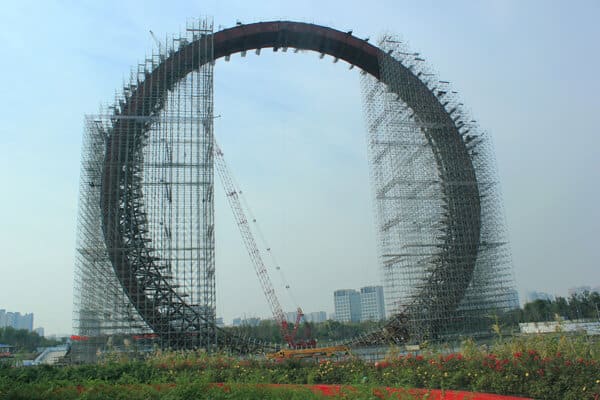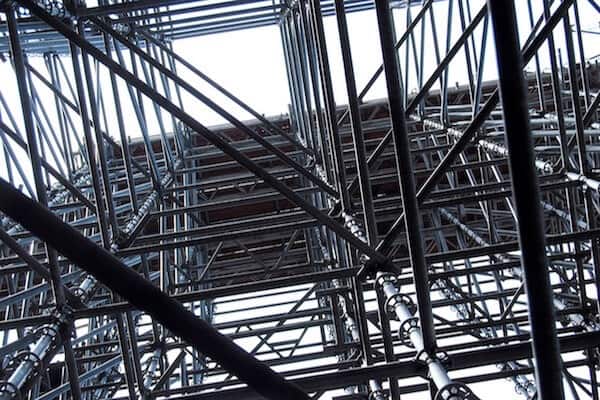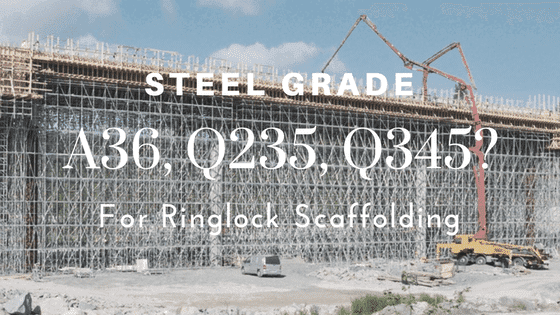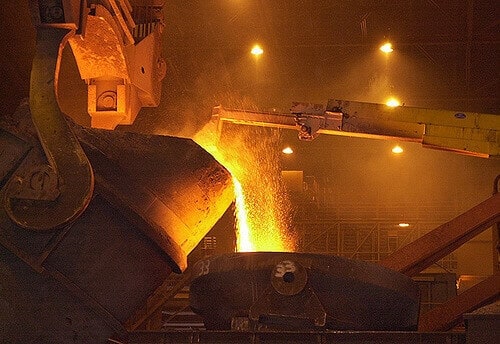Everyone talks of climbing the ladder to success, but how about adding a slight twist to it? Scaffolding can take the place of the ladder, especially when the climb is extremely high. So let’s give it its due and learn more about it.
In this post, we’ll be throwing some light on system scaffolding.
Contents
- System scaffolding
- 1. Ringlock Scaffolding
- 2. Cuplock Scaffolding
- 3. Kwikstage Scaffolding
- 4. Haki
- 5. Frame Scaffolding
- 6. Shoring Props
- Conclusion
- Modular Scaffold – The Ultimate FAQ Guide
- What is a Modular Scaffold?
- Types of Scaffolding Systems
- Modular Scaffolding
- System Scaffolding
- What Are the Uses of Modular Scaffold?
- Major Types of Modular Scaffolding in Construction
- Cuplock Scaffolding
- Ringlock Scaffolding
- Kwikstage Scaffolding
- What is the Maximum Height of a Modular Scaffold?
- Is Modular Scaffold Similar to Tubular Scaffold?
- Comparing Tubular Scaffolding to Modular Scaffolding
- Modular Scaffold Parts
- Advantages of Modular Scaffolding
- Safety and Security
- Flexibility and Versatility
- Convenience and Ease of Use
- Are There Any Disadvantages or Drawbacks to Modular Scaffolding?
- Initial Costs and Expenses
- Complex Design Requirement
- Not Flexible and Adaptable
- What Is Prefabricated Scaffolding?
- Who Benefits the Most From Modular Scaffolding?
- How is Scaffolding Fixed/Erected to a Building?
- What is Kwikstage Scaffolding?
- Where Can You Find the Best Modular Scaffold?
System scaffolding
System scaffolding, also known as modular scaffolding, comprises pre-engineered horizontal and vertical parts that are joined together in a certain order that makes it easy for users to use it to ascend and descend structures.
These scaffoldings are popular across the world and in great demand, with each type fulfilling a specific purpose.
Some system scaffoldings are meant for use in high volume settings, while others are used in smaller structures.
System scaffoldings are of different types and can be used to create homogenous scaffolding bays.
Let’s have a look some of the most popular types…
- 1. Ringlock Scaffolding
- 2. Cuplock Scaffolding
- 3. Kwikstage Scaffolding
- 4. Haki
- 5. Frame Scaffolding
- 6. Shoring Props
- Conclusion
1. Ringlock Scaffolding
Ringlock scaffolding is made from prefabricated components, wherein each part is designed to serve a specific purpose. Scaffolding contractors and construction companies prefer to use ring lock because it is quick and easy to install and adapt to serve different needs.
It comes equipped with a unique set of features and benefits, from being lightweight but sturdy to its one-of-a-kind rosette-type central connector. These features allow ring lock scaffolds to exhibit its varied capabilities for complex geometries. Further, it also offers tremendous flexibility and is cost-effective.
Ringlock can be used in several industries and extreme environmental conditions (on and off shore) as it is manufactured from high-strength, lightweight galvanized steel. Its pre-fabricated nature allows for quick installation, which in turn, helps increase productivity.
Hence, when it comes to high load-handling strength, you want to go for ringlock scaffolding as it is modern, versatile and extremely strong compared to its counterparts. Some of the components that make up this masterpiece include multiple ledgers, guard rails, stair stringers, connectors, clamp, steps, and adapters.
Ringlock scaffolding is great for use as it provides tremendous flexibility and aligns 45o/90o using the notch. So you will be able to lock in various number of angles. One of the best things about it is that it offers 8 connections within different system segments. These come in a rosette arrangement and can be self-locked using a hammer. This means it supports several build types like slab formwork, bridge formwork, and so on.
Further, ringlock scaffolding offers high level of stability in its class. It is supported with a vertical rod, a bar, and diagonal horizontal and vertical structures, which look like a secure lattice system.
More often than not, ringlock scaffolding is hot-dip galvanized which protects it from corrosion. This, in turn, improves the life span and dependability of the scaffolding and its components.
Also, this scaffolding is easy to assemble and dismantle, which makes it easy for users to transport and store it. It commonly finds use in projects that involve building of houses (façade scaffolding and load-bearing support scaffolding), decorating at heights, petrochemical engineering, hydraulic engineering, metallurgical engineering, bridge construction, offshore platform, construction of tall status, outdoor advertising, and public events (installing seats platform, light shelf, film sling).
2. Cuplock Scaffolding
Made from galvanized steel, this type of scaffolding is used to a great extent because of its ability to sustain heavy loads. If you want a scaffolding design with repeated patterns, then cuplocks will have to be placed at every 500mm to 1,000mm for optimum strength and support, and to create effective and standardized systems.
Cuplock scaffolding is easy to erect and can stand without needing nuts and bolts or wedges to fasten the horizontals. There are no tiny parts that can be damaged or lost, which adds to the convenience of using cuplock scaffolds. All it needs is a locking cup at every node point on the standards so that the ends include up to four members in a single locking action. This means you can do your job much faster.
Thanks to the versatility of cuplock scaffolding, it is best suited for access or framework support. It is durable enough to be used in construction and it works with a variety of support structures. This type of system scaffolding is widely used in the construction of houses, chimneys, tunnels, dams, and bridges. It is also used in demolition and maintenance projects for both, straight and curved structures. Cuplock scaffolding also work well in projects that involve construction of overpass and railway viaducts.
Cuplock scaffolds come with only four horizontals that can be quickly fastened at one time. The firm clamping action of the topmost cup secures the joint, which makes it a reliable and high-performance scaffolding structure. Thanks to the bar accessories, loading and unloading becomes easy.
This type of scaffolding is easy to transport as the material used is single pipes. It also requires less storage space and offers long lasting support compared to other types of scaffolding.
Cuplock scaffolds may be lightweight, but have high capacity for supporting heavy loads. The time-tested design and the safety accessories that are used in erecting cuplock scaffolding meet the safety requirements of the various statutory bodies. They’re low maintenance and designed to reduce occurrences of accidents.
3. Kwikstage Scaffolding
This type of scaffolding is particularly popular in the UK and Australia. The name of the scaffolding may drop a hint: it is quick to erect and is adaptable, and finds uses on both, commercial and residential sites. They’re mostly used by construction workers, roofers, bricklayers, painters, carpenters, and masons on an everyday basis along with other tools. They use this scaffolding to move around on the site of their work and transport material.
Assembling and dismantling the kwikstage scaffolding is easy as it comes with just five parts. It is steadfast and safe for use as it is equipped with double guard rails and non-slip platforms. This is why different types of workers find it easy to use this scaffolding. Whether they are skilled, semi-skilled or unskilled, all workers in various industries can use it.
What’s more? Kwikstage scaffolding is also used by professionals like engineers, architects, city planners, and site inspectors to perform their daily duties confidently. It is most useful in building houses (façade scaffolding).
Because the scaffolding is adequately tested to meet the highest quality standards in the industry in terms of supporting the heaviest of weights, users are assured of their safety.
4. Haki
Haki is a modern-age system that is used in scaffolding, and shoring and suspended systems. This high-quality system offers the utmost safety and flexibility. It is light in weight as it has fewer parts compared to other systems.
When it comes to Haki, the bay length tends to measure up to three meters. This system has adjustable feet and comes in various heights ranging from one and a half meters to two meters. These features help in ensuring that the system is erected to the right levels for gaining access to floor and scaffolding levels.
This system comes fortified with handrails and toe boards (if required), which make it a highly resilient and long-lasting system.
Haki system installations can be used for basic construction work, when building temporary roofs, performing brickwork repairs, working in refineries and shipyards, and in building renovation and restoration jobs. They’re also useful in refurbishing projects and construction of temporary bridges over rivers.
5. Frame Scaffolding
One of the most common type of system scaffolding found on construction sites is the frame scaffolding. It is usually available in different configurations – sections that contain ladders and a walk-through portal, sections that are actually walk-though, and those that look like a ladder.
Typically, frame scaffolding is set up by using two sections of the scaffold frame that are connected by two crossed sections of support poles that are organized in a square shape. New sections are assembled on top of the preceding sections. These sections are then used by workers to reach the desired height to carry out their work. Ropes are hung from the topmost section to enable workers to pull materials up to their level. Workers often carry out their duties from multiple levels of the frame scaffolding.
Frame scaffolding is easy to erect and disassemble. It perfect for use in general masonry, maintenance, all kinds of façade work like renovation, restoration, claddings and shoring. It can also be employed for building houses (façade scaffolding and load-bearing support scaffolding) and decoration projects. It offers a wide selection of frame lock types and tube sizes with robust steel tubing. This makes it safe, reliable and efficient.
6. Shoring Props
Shoring props are used in an array of medium-height false work and building support work, including internal demolition. They are highly robust in nature, height-adjustable to a great extent and come with head plates for modern formwork systems. They also provide the most cost-effective means to support all types of formwork, slabs, walls, beams, and columns.
Preferred for performing a range of applications in general building construction and repairs, shoring props help save labor costs and the time taken for cutting timber, and wedging and nailing. Typically, steel shoring props are used in the construction of heavy structures (load-bearing support scaffolding) like culverts, bridges, staging of retaining walls, floor slab concrete pouring, and so on.
Benefits offered by shoring props include the ease of assembling and dismantling, safety, efficiency, and high load-carrying capacity. Also, it comes with no loose components so there’s no fear of losing anything. It offers flexibility in terms of being available in various sizes and different load-supporting capacities to suit changing needs. Steel shoring props are durable as the steel material ensures strength and longevity. It also reduces the risk of corrosion to a great extent.
Conclusion
Scaffolding is an important part of the construction industry. No structure can be completed without employing reliable and robust scaffolding. However, workers lives are on the line when they use it, so it is important that it is safe for use. Choosing the right scaffolding for any construction task can ensure this. Use the above information to educate yourself about the various system scaffolding available before taking your pick for your project.
Modular Scaffold – The Ultimate FAQ Guide
Do you know what a modular scaffold is? Have you even ever seen or encountered the term before? For newer scaffolding experts and businessmen, you should already know what it is. But do you really get what it’s trying to do?
In this guide we here at Total Contec prepared, we will be giving you the full understanding of what modular scaffold is. Not only that, but we will also provide the necessary information you need in order to pursue it.
What is a Modular Scaffold?
A modular scaffold is a type of system scaffolding that’s usually completed using prefabricated parts and components. Overall, this system is based on the tube coupling method or wedge, which completely enables the connection.
While this is its basis, it is not entirely similar to the tube and coupler scaffolding type – we’ll get to that in the latter part of this guide.
Types of Scaffolding Systems
There are different classifications and categorizations of scaffolding. But when it comes to the simplest and most basic ones, the types are modular and systems scaffolding.
Here are some of the things you ought to know about them.
Modular Scaffolding
This is the type of scaffolding that involves the use of various modules in order to form a base or a foundation. Modular scaffolding is seen as an effective means of scaffolding if you are working on the exterior part of a building because of this characteristic.
System Scaffolding
Systems scaffolding, on the other hand, is the type of scaffolding that makes use of fixed connections with posts that are ready for attachment and linkage. These include bearers, diagonals, and runners and have excellent linking points that can perform the necessary type of job.
As you can see, they are similar types of scaffolding and the only difference would be the terms – which point toward how they differ in the materials that are used.
What Are the Uses of Modular Scaffold?
Because of how it’s put up, you can expect to use modular scaffold in a wide range of business sectors and industries that involve construction and structural projects. The most common, however, would be:
- Oil and Gas Industry
- Construction and Structural Industry
- Marine and Maritime Industry
- Chemical Plants
- Architecture and Engineering Industry
- Renovation and Demolition
- And Many More!
Whatever industry that requires specific heights, modular scaffolding can be of dire assistance!
Major Types of Modular Scaffolding in Construction
Modular scaffolding can be seen in many different forms. What this simply means is, it can be categorized into a few groups. To help you with it, though, the major types and names in modular scaffolding include:
Cuplock Scaffolding
Cuplock scaffolding is a type of modular scaffolding that’s identified as the joining method that makes use of metal cups to interlock and conjoin standards or metal beams together. This type of scaffolding does not use nuts, bolts, and threads.
Ringlock Scaffolding
Ringlock scaffolding is a modular scaffolding category that uses rings instead of cups – this is its only difference with cuplock scaffolding.
Kwikstage Scaffolding
Last and most definitely not least is Kwikstage scaffolding. It’s usually made up of steel tubes, as well as certain types of fasteners to finish the job.
NOTE: There are a few other types of modular scaffolding in the market. These are just the more popular and sought-after ones you will encounter!
What is the Maximum Height of a Modular Scaffold?
The overall maximum height allowed as per the Occupational Safety and Health Administration of modular scaffolding would be at a height of 12 meters (39 feet). However, this can change depending on the restrictions and the certificates acquired by a company.
Is Modular Scaffold Similar to Tubular Scaffold?
No, modular scaffolding is not the same as tubular scaffold. For you to understand it further, let me give you a brief and quick description of each.
Modular scaffolding consists of a few fixed points that can accommodate bearers, diagonals, standards, and runners. Any of these independent modules or units should form a base.
Tubular scaffolding, on the other hand, otherwise known as tube and clamp or tube and coupler scaffolding is the simplest, most basic, and most traditional type of scaffolding . In this scaffolding type, the components are connected and linked together with the help and assistance of couplers and fasteners.
The major strength of modular scaffolding is its urgency and quickness in erection. On the contrary, tubular scaffolding takes pride on its adaptability and flexibility to the working environment.
Comparing Tubular Scaffolding to Modular Scaffolding
Before we talk about their indifferences, let us first discuss where they are similar.
Both modular and tubular scaffolding employ the use of tubes and points to be able to build and erect the tower. Furthermore, these scaffolding types would need careful and thorough examination of the loading capacity.
Here’s a brief table that would help you understand their differences more:
| Scaffolding Characteristic | Modular | Tubular |
| Cost | Costlier and more expensive than tubular scaffolding. | More affordable and easier to acquire. |
| Flexibility | Requires initial sizing – not openly flexible and adaptable. | Flexible in almost all types of scenarios and business uses. |
| Design Requirement | Requires complex design and structure ideologies. | Does not need complexity and experience when it comes to designing. |
| Timing | Super-fast and easy to set up and use. | Slow and labor-intensive to set up. |
| Safety and Security | Erection and working principles are both extremely safe and secure. | Safe and secure, but not as safe as modular scaffolding. |
| Industry | Primary use would be in the oil and gas industry, as well as the civil engineering industry. | Primary use would be in the residential and commercial industry. |
These are the points of difference of these two (2) types of scaffolding.
Modular Scaffold Parts
The parts and components of modular scaffolds vary depending on what the type of project is, the height that is to be achieved, and of course, the materials needed.
Nevertheless, the general parts of modular scaffolding include:
- Standards
- Couplers
- Base Plates (Base Jacks)
- Ledgers (Horizontal Braces)
- Diagonal Braces
- Toe Boards
- Staircases
- And Others
NOTE: Some are industry-specific and project-specific.
Advantages of Modular Scaffolding
Modular scaffolding employs a few benefits and advantages. You might be surprised at how well it has performed. Nevertheless, the following are considered the primary benefits and advantages of modular scaffolding:
Safety and Security
This actually, is one of the major advantages and benefits of using a modular scaffold. They’re built safely and securely with an interlocking system that helps to prevent the likelihood of failure, property damage, and of course – injury.
All components in modular scaffolding is built for the purpose of protection and security!
Flexibility and Versatility
In terms of customization, modular scaffolding is adaptable and versatile. Tubular scaffolding is better in terms of on-the-spot adaptability, but modular scaffolding won’t fail you when it comes to how flexibly you can customize and work on it.
Convenience and Ease of Use
Of course, the benefit that many people want would be how convenient modular scaffolding is. Modular scaffolding is a convenient way for both workers and owners. It is convenient for owners because the working height, space, and overall room is workable, versus other types of scaffolding where there are limitations and restrictions in space.
NOTE: These are just some of the major benefits and advantages of using modular scaffolding. Of course, there are other pros and benefits to it, but you’ll be able to figure it out when you start employing the use of the scaffold itself.
Are There Any Disadvantages or Drawbacks to Modular Scaffolding?
Akin to the advantages, you’ll also be able to find cons or drawbacks to using modular scaffolding. These drawbacks include, but are not limited to:
Initial Costs and Expenses
Of course, the con or disadvantage that we all hate – cost. Because of all the properties and characteristics it possesses, you need to expect paying a premium for it. It’s not like it’s extremely well and efficient without paying the price, right?
Complex Design Requirement
Another would be the complexity and requirement of its overall design. The modular scaffolding system isn’t for the faint of heart – it is something that requires constant checking and modifications in order to attain the wanted and needed design for it.
Not Flexible and Adaptable
And of course, compared to the age-old scaffolding, it is not flexible. Since the materials are going to be pre-made or pre-fabricated, there needs to be a complete initial check and assessment of the parts and components to see if it will fit well to the height and size of the scaffold.
As you may have noticed, all these are overpowered by the pros and advantages, right? So, you shouldn’t worry about these drawbacks at all.
What Is Prefabricated Scaffolding?
Pre-fabricated scaffolding, from its term alone, is a type of modular scaffolding where the components are already pre-made or pre-fabricated. It is labelled and termed as “pre-fabricated” because all workers need to do is to integrate all components together in order to assemble the scaffold.
There’ll be no more drilling, cutting, sawing, subtracting, or adding of material – they’re already pre-made or pre-fabricated.
Who Benefits the Most From Modular Scaffolding?
Many professionals and experts have benefited from using modular scaffolding. The most professions that did benefit from it include, but are not limited to:
- Carpenters
- Architects
- Engineers
- Bricklayers and Construction Workers
- City Planners
- Private and Public Inspectors
- Masons
- And Many More!
Other than these, though, many other professionals and experts benefit from modular scaffolding.
How is Scaffolding Fixed/Erected to a Building?
For suspended scaffolding, a type of the primary categories of scaffolding, it is the type where the scaffolding is affixed, resting, and latching onto the building instead of being assembled from the ground.
On the contrary, supported scaffolding can also be fixed to a building by a means of an integrated ground-level attachment.
There are many different ways of how companies affix and install scaffolding onto buildings, but the most common way of erecting it would be by doing the following procedure:
- The base or foundation of the scaffolding is made and installed.
- For the case of suspended scaffolding, the attachment or the ties are pre-positioned.
- Once done, the standards and ledgers are going to be positioned as the receiving end.
- For the case of suspended scaffolding, the ties need to be double-checked and re-assessed to ensure that it wouldn’t fall off or break down.
- After that, the scaffolding structure is started for the creation of the first layer, and then the second layer, and so forth.
NOTE: For each layer, there needs to be some type of security function or feature to ensure that each level is independent. Just because they’re towers, doesn’t mean they’ll fall off when a single layer or level does.
What is Kwikstage Scaffolding?
Kwikstage scaffolding is one of the types of modular scaffolding that’s identified as having a “wedge fixing” for all accesses to the scaffold requirements. These fixings help out in transforming the ledger via fast means of erection without suffering loosened parts.
FUN FACT: The very first Kwikstage scaffolding systems have been created and innovated by RMD Kwikform in 1948. Since then, Kwikstage scaffolding is identified as one of the types of modular scaffolding because of how effective and efficient it is.
Where Can You Find the Best Modular Scaffold?
In the entire country, no other modular scaffold manufacturing company is as excellent as us here at Total Contec. We’re considered by many as their one-stop manufacturer for all different types of modular and system scaffolding they need.
We are experts in Kwikstage, tube and couple, ringlock, cuplock, and even HAKI scaffolding. Not only that, but you can also bank and count on us if you ever find yourself in need of PPE or personal protective equipment for your projects!
Reach out to us and we’ll be more than happy to help you with all your modular scaffolding needs!
Not sure of what you need to get? Consult with us and we will help you identify what exactly it is that you need! We have experts ranging from sets of engineers, pre-fabrication professionals, and even experienced construction experts to help you!





